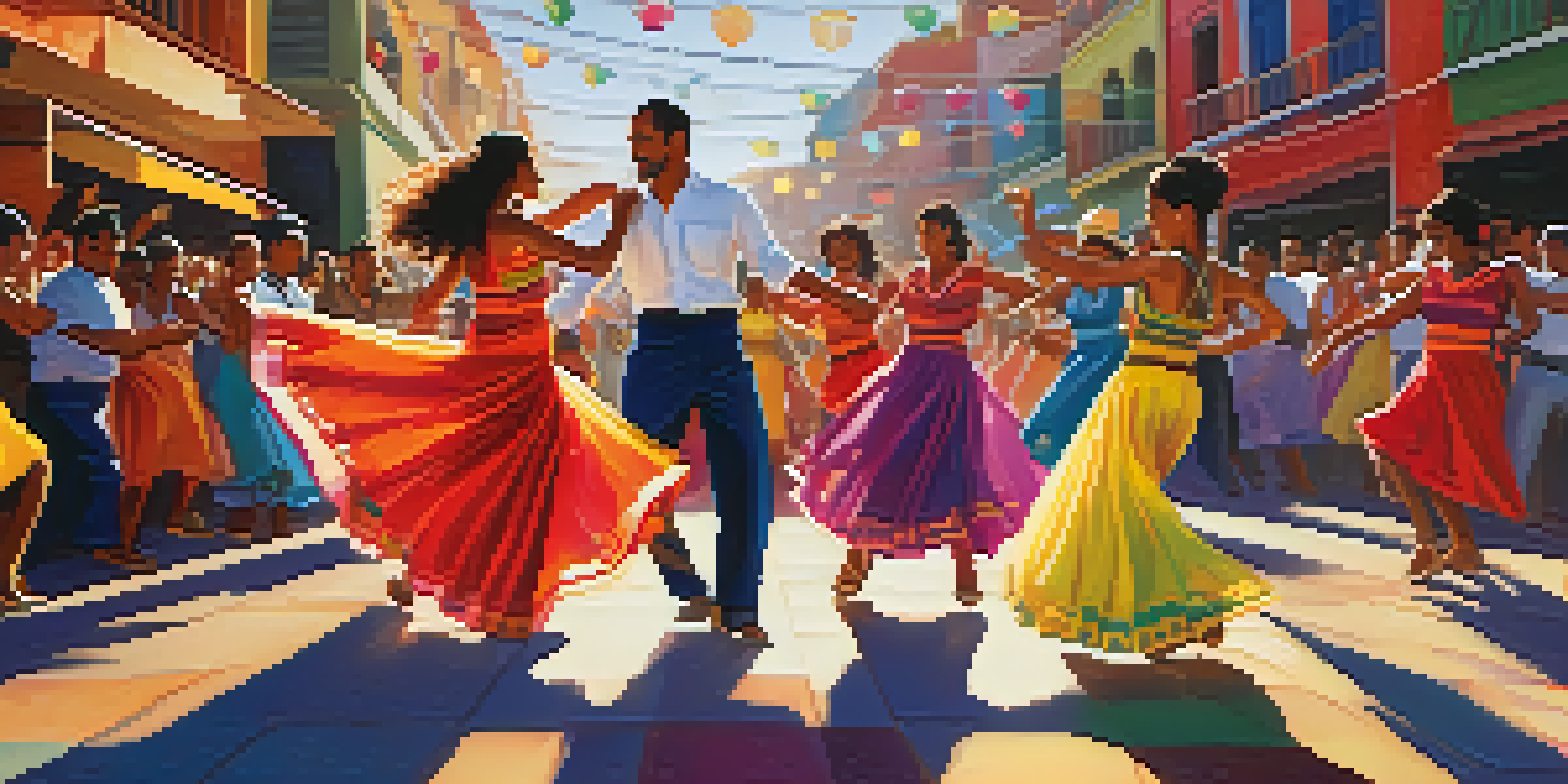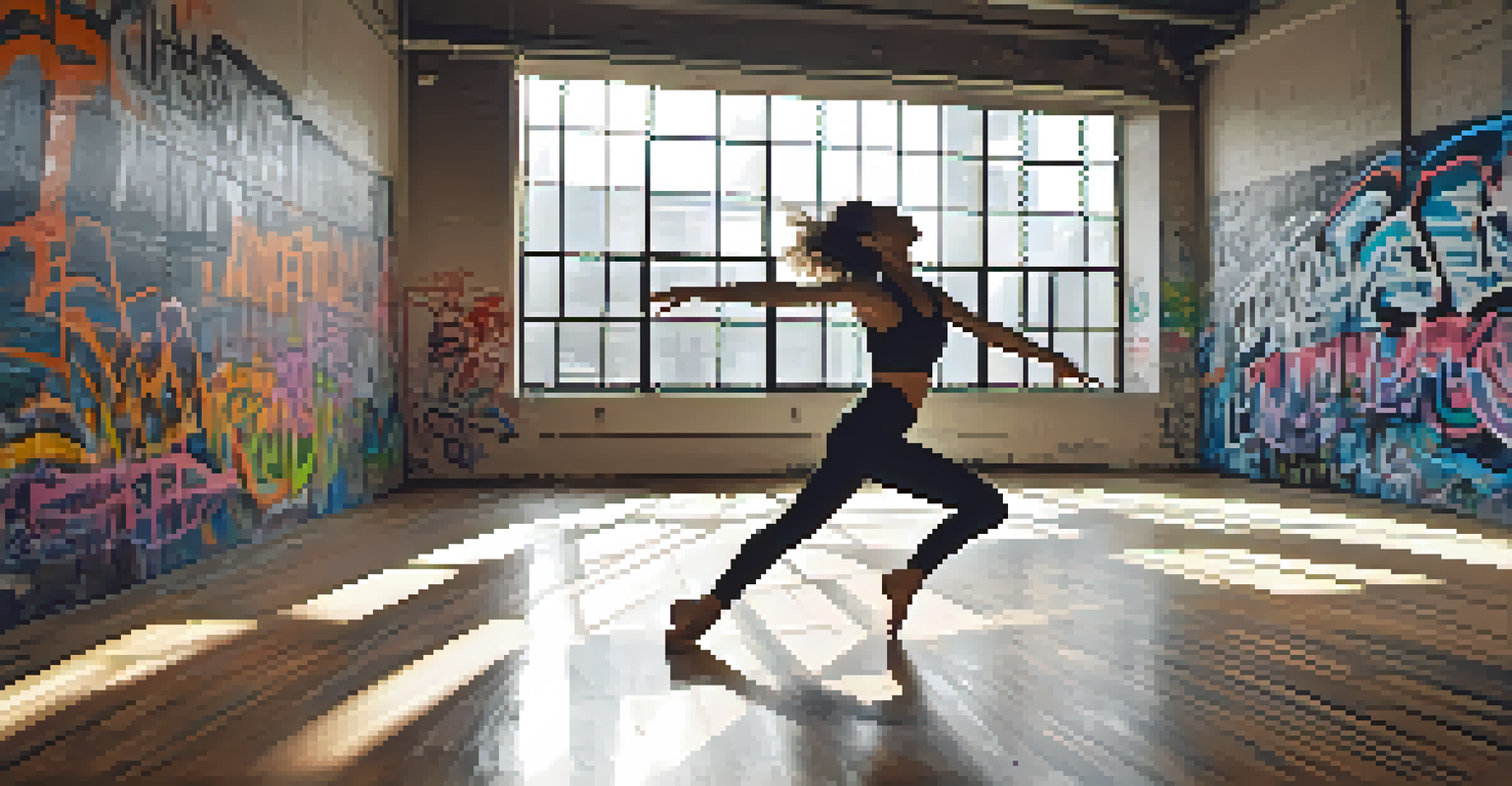Exploring Sound: The Synergy Between Dance and Music

The Intrinsic Connection Between Dance and Music
Dance and music have shared a symbiotic relationship for centuries, each enhancing the other in profound ways. When we think of dance, we often picture rhythmic movements that are perfectly timed to a musical beat. This connection is not just a coincidence; it stems from the deep emotional and physical responses both art forms evoke in us.
Dance is the hidden language of the soul.
Consider a lively salsa dance; the vibrant music compels the dancer to move, while the dancer's energy can elevate the music, creating a dynamic interplay. This back-and-forth amplifies the experience for both the performer and the audience, making it a celebration of life and expression. Without music, dance would lack rhythm and context, while music alone can feel incomplete without the visual storytelling of dance.
This intrinsic connection is evident across cultures, showcasing how universal the language of music and movement can be. From traditional folk dances that tell stories to contemporary forms that explore new narratives, the synergy between sound and movement continues to evolve and inspire.
The Role of Rhythm in Dance
Rhythm is the heartbeat of both music and dance, serving as the foundation upon which movements are built. In dance, rhythm dictates the timing and pattern of each step, creating a framework that dancers follow as they express themselves. It's fascinating to see how even the slightest change in tempo can completely alter a dance's style and mood.

For example, a fast-paced hip-hop track encourages energetic, sharp movements, while a slow ballad invites graceful, fluid motions. This relationship illustrates how rhythm not only prompts physical movement but also influences the emotional tone of a performance. Dancers often rely on the rhythm to guide their interpretation, allowing them to connect more deeply with the music.
Dance and Music's Symbiotic Bond
Dance and music have a deep-rooted connection, enhancing each other's emotional and physical expressions across various cultures.
Moreover, the understanding of rhythm can vary across different dance styles, highlighting cultural nuances. Whether it's the infectious beat of African dance or the syncopated steps of jazz, each rhythm tells a unique story that enhances the overall experience.
Melody and Emotion in Dance
Melody plays a crucial role in conveying emotion within dance, allowing performers to express feelings that might be difficult to articulate verbally. A poignant melody can evoke nostalgia, joy, or even sorrow, serving as a backdrop that dancers interpret through movement. This emotional connection transforms a performance into a powerful shared experience for both the artist and the audience.
Music can change the world because it can change people.
Take a ballet performance set to Tchaikovsky's music, for example; the sweeping melodies guide the dancers' movements, enhancing the storytelling aspect. The grace of their movements mirrors the emotive highs and lows of the melody, creating a captivating narrative. Here, the synergy between melody and movement becomes a dance of emotions that resonates deeply with spectators.
Furthermore, dancers often choose specific pieces of music that align with their artistic vision, proving that the right melody can elevate a performance. By tapping into the emotional core of the music, dancers become storytellers, inviting audiences to feel alongside them.
Cultural Influences on Dance and Music
Dance and music are deeply rooted in culture, reflecting the values, history, and traditions of different societies. Each culture has its own unique forms of dance and accompanying music, often intertwined in celebrations, rituals, and communal gatherings. This rich tapestry of cultural expression showcases how dance and music can serve as a medium for storytelling and connection.
For instance, traditional Indian dance forms, such as Bharatanatyam, incorporate intricate footwork and hand gestures that are inextricably linked to classical music. This synergy not only entertains but also preserves cultural heritage, allowing future generations to experience and appreciate their roots. Similarly, African dance often features call-and-response patterns in music, fostering community engagement and participation.
Rhythm Shapes Dance Expression
Rhythm acts as the foundation of dance, influencing the timing, style, and emotional tone of movements.
As globalization continues to influence art forms, we see exciting cross-cultural collaborations emerge. Dancers and musicians from different backgrounds are coming together, merging styles and creating innovative performances that celebrate diversity while honoring their origins.
Improvisation: The Dance of Freedom
Improvisation in dance is a beautiful expression of spontaneity, where dancers respond instinctively to the music in real-time. This practice allows for a unique interpretation of music, showcasing the dancer's personality and creativity. The freedom to improvise can lead to performances that feel fresh and alive, captivating audiences with their unpredictability.
Consider a jazz dance session; the music often encourages dancers to experiment with their movements, taking risks and exploring new ideas. This organic connection can lead to unexpected moments of brilliance, where the dancer and musician become one. In these moments, the boundaries between the two art forms blur, creating a unique synergy that’s exhilarating to witness.
Moreover, improvisation serves as a powerful tool for self-expression, allowing dancers to convey their emotions and experiences. By embracing spontaneity, they not only connect with the music but also with themselves, creating a performance that is both personal and relatable.
The Impact of Technology on Dance and Music
The advent of technology has transformed how we create and experience dance and music, opening new avenues for collaboration and innovation. Digital tools enable artists to produce music with unprecedented precision, while also allowing dancers to explore new styles and forms. This fusion of technology has sparked fresh perspectives and possibilities in both fields.
For instance, the use of electronic music in contemporary dance has led to innovative performances that blend visuals and sound in exciting ways. Dance companies are utilizing projection mapping and interactive installations that respond to movement, enhancing the audience's experience. This technological interplay creates an immersive environment that captivates viewers and challenges traditional notions of performance.
Cultural Influence on Performance Art
Dance and music reflect cultural values and traditions, showcasing diverse storytelling methods and fostering community engagement.
Moreover, social media platforms have allowed dancers to showcase their work globally, fostering a sense of community and connection. Artists can share their interpretations of music, collaborate with others, and even participate in viral dance challenges, demonstrating how technology has democratized the art forms.
The Future of Dance and Music Collaboration
As we look ahead, the collaboration between dance and music continues to evolve, driven by creativity and innovation. Emerging artists are experimenting with new genres and styles, blending traditional influences with contemporary elements. This exploration not only keeps the art forms relevant but also invites audiences to engage with fresh perspectives.
Moreover, interdisciplinary projects that combine dance, music, visual arts, and technology are gaining traction, creating multi-sensory experiences that challenge the status quo. These collaborations are redefining how we perceive dance and music, encouraging audiences to interact with performances in new and meaningful ways. As artists push boundaries, the future promises dynamic and exciting developments.

Ultimately, the synergy between dance and music will remain a powerful force for expression, connection, and creativity. As long as there are people passionate about these art forms, we can expect to see performances that inspire, challenge, and move us in profound ways.